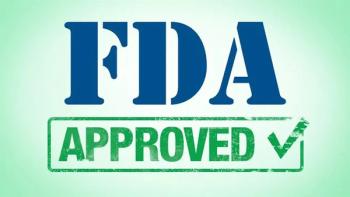
FDA Grants Fast Track Designation to ZL-1310 in Extensive Stage SCLC
The agent is currently being evaluated as both monotherapy and in combination with atezolizumab in patients with extensive stage SCLC in an ongoing, global phase 1 trial.
The FDA granted fast track designation to ZL-1310, a potential first-in-class DLL3-targeted antibody-drug conjugate (ADC), to treat patients with extensive-stage small cell lung cancer (ES-SCLC).1
The agent is currently being evaluated as both monotherapy and in combination with atezolizumab (Tecentriq) in patients with ES-SCLC in an ongoing, global phase 1 trial (NCT06179069).2
Interim data from the monotherapy dose-escalation portion (part 1a) of the trial presented at the EORTC-NCI-AACR Symposium in October 2024 demonstrated early antitumor activity with ZL-1310 in 25 patients treated across 4 tested dose levels (0.8 mg/kg, 1.6 mg/kg, 2.0 mg/kg, and 2.4 mg/kg). Among 19 patients who received at least 1 post-treatment tumor assessment, the overall response rate (ORR) was 74% (95% CI, 48.8%-90.9%). Responses were observed in patients with DLL3 H-scores as low as 5 (range, 5-260); no response was reported in 1 patient whose tumor lacked DLL3 expression.
Zai Lab, the drug’s developer, will present updated data from this study at the
“The FDA’s decision to grant fast track designation to ZL-1310 highlights the significant need for expanded treatment options for patients with SCLC and represents an important step in our efforts to advance a novel therapeutic option as quickly as possible,” Rafael G. Amado, MD, president and head of Global Research and Development at Zai Lab, stated in a news release. “This designation reinforces the clinical progress we have achieved for ZL-1310 to date, and we remain on track to initiate a pivotal study in SCLC after this year, positioning us for a potential accelerated approval in 2027.”
Notably, ZL-1310 was previously granted orphan drug designation for SCLC by the FDA in January 2025.3
Phase 1 Study Overview
ZL-1310 is an investigational ADC that consists of a humanized anti-DLL3 monoclonal antibody attached via a cleavable linker to a novel camptothecin derivative, a topoisomerase I inhibitor. The agent was developed using the TMALIN® ADC platform, which is designed to exploit characteristics of the tumor microenvironment to improve drug delivery and efficacy, potentially addressing limitations observed with earlier-generation ADCs.
The open-label, ascending, multiple-dose, phase 1 study is evaluating the safety, tolerability, and pharmacokinetics of ZL-1310 in patients at least 18 years of age with histologically or cytologically confirmed metastatic SCLC or ES-SCLC who have documented disease progression during or after receiving platinum-based chemotherapy.4 Patients must also have previous exposure to no more than 3 regimens in the metastatic or ES settings; 1 measurable target lesion per RECIST 1.1 criteria; an ECOG performance status of 0 or 1; and a life expectancy of more than 3 months.
In the dose-escalation phase, patients are being treated with ZL-1310 as a single agent (arm 1) or in combination with atezolizumab (arm 2). In the dose-expansion portion, patients are being treated with ZL-1310 at dose level 1, dose level 2, or in combination with atezolizumab and carboplatin induction therapy, followed by ZL-1310 and atezolizumab as maintenance.
The trial’s primary end points are the incidence of dose-limiting toxicities (DLTs), treatment-emergent adverse effects (TEAEs), and serious TEAEs. Secondary end points include ORR, duration of response (DOR), progression-free survival, disease control rate, and overall survival, as well as pharmacokinetics.
Additional Efficacy and Safety Data
Notably, all patients enrolled onto the study experienced disease progression following prior platinum-based chemotherapy, and 92% had also progressed on immune checkpoint inhibitors.2 More than half (56%) had received 2 or more prior lines of therapy, and 28% had brain metastases at study entry. As of the October 10, 2024, data cutoff, 19 patients had undergone post-baseline tumor assessments per RECIST 1.1 criteria, and DLL3 expression was evaluable in 16 of these patients.
Of the 14 responders, 13 remained on treatment at the time of data cutoff, with the longest response ongoing at 6.5+ months. The median follow-up was 2.4 months, and the median DOR was not yet estimable. Notably, all 6 evaluable patients with baseline brain metastases achieved a partial response (PR), and 1 patient previously treated with a DLL3-directed bispecific agent also experienced a PR at first evaluation.
In the safety-evaluable population (n = 25), ZL-1310 was generally well tolerated. Most TEAEs were grade 1 or 2 in severity. One DLT of grade 4 transient neutropenia and thrombocytopenia was reported at the 2.4-mg/kg dose. Grade 3 or higher treatment-related AEs (TRAEs) occurred in 20% of patients, with neutropenia being the most frequent (12%). Serious TRAEs were reported in 2 patients (8%), and 3 patients (12%) required dose reductions; no patients discontinued therapy due to TEAEs.
References
- Zai Lab receives U.S. FDA fast track designation for ZL-1310, a DLL3-targeted antibody-drug conjugate, for treatment of extensive-stage small cell lung cancer. News Release. Zai Lab. May 19, 2025. Accessed May 19, 2025. https://ir.zailaboratory.com/news-releases/news-release-details/zai-lab-receives-us-fda-fast-track-designation-zl-1310-dll3
- ZL-1310, an investigational DLL3-targeted antibody-drug conjugate (ADC), demonstrates promising objective response rates and safety profile in extensive-stage small cell lung cancer). News Release. Zai Lab. October 24, 2024. Accessed May 19, 2025. https://ir.zailaboratory.com/news-releases/news-release-details/zl-1310-investigational-dll3-targeted-antibody-drug-conjugate
- Zai Lab receives orphan drug designation from the U.S. FDA for ZL-1310 (DLL3 ADC) for the Treatment of small cell lung cancer (SCLC). News Release. Zai Lab. January 22, 2025. Accessed May 19, 2025. https://ir.zailaboratory.com/news-releases/news-release-details/zai-lab-receives-orphan-drug-designation-us-fda-zl-1310-dll3-adc
- A study of ZL-1310 in subjects with small cell lung cancer. ClinicalTrials.gov. Updated January 1, 2025. Accessed May 19, 2025. https://clinical
Newsletter
Knowledge is power. Don’t miss the most recent breakthroughs in cancer care.
















































































